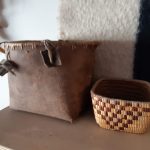Marriage: a European or an Indigenous wife?
“Country marriages” were common-law marriages between European men and Indigenous women. Many newcomers depended on the expertise of their Indigenous “country wife”, as they were called, for their very lives. These women knew the land, where to find food, and how to prepare it. Their family connections often linked them to several First Nations, which proved to be profitable in enhancing their husband’s contacts in the fur trade and in securing access to the resources needed for survival.
Intercultural marriages were the norm in the early years. Most relationships evolved over the long term and depended on the strength of families. Some Indigenous women of the late 19th century did move with their extended families in a semi-nomadic life linked to seasonal rhythms. They chose short-lived relationships with successive partners.
As time went on, some men — fur traders and settlers alike — turned their backs on their “country wives” and children. These men chose to go home to Europe or to Eastern Canada to select their “true” brides. They abandoned their original families altogether to marry White women who would fit BC’s new colonial society.
While ranching life became a great equalizer where the only hierarchy was based on achievement, an awareness of ancestry remained. Mixed-ancestry descendants were part of the population, but they were linked to one of two groups – White or Indigenous — and subject to the benefits and challenges of each. In most of BC, Métis identity was not an established heritage.


